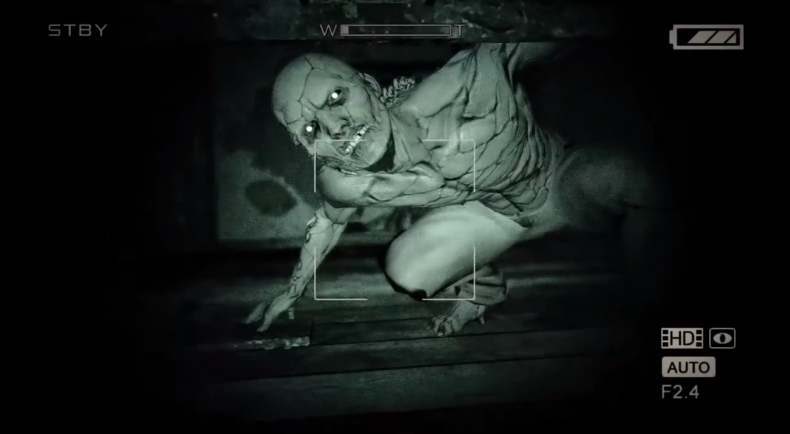Outlast Review

Awesome gameplay-- and not something to play alone in the dark. Terrifying, fast-paced, and a whole lot of fun.
None. Just buy this.
Definitely buy this. It's terrifying and great fun to play. It has the tendency to feel like an amalgamation of a lot of other games without being immediately identifiable as derivative of any of them. In creating Outlast, Red Barrels lifted some of the best qualities of the genre and made them their own. You'll love it, and you'll probably hate it a little too-- for all the best reasons.
Outlast, by Montreal-based Red Barrels, is an exercise in pure survival horror.  Red Barrels has a doozy of a team made up of EA and Ubisoft vets who clearly decided to take what makes survival horror games most successful and mash them together in a clean, uncomplicated horror game: terror, survival, and a lack of resources.  Outlast is tense and claustrophobic and frankly just great fun to play, and for fans of the genre, it’s a must-buy.
You may have to stop and take a break, go get a drink, come back several hours later, let your nerves settle. Â Don’t worry, nobody can hear you scream.
Story/Concept
You are Miles Upshur, a reporter who, after receiving an anonymous tip, drives to the moody Mount Massive Asylum, run by the (naturally) shady Murkoff Corporation (Umbrella-style), to investigate. Â Flashing figures in the windows and empty military riot vehicles in the driveway are the kind of indication that you should run very, very far away, but this wouldn’t be a survival horror game if you do. Â So you hop on some scaffolding and push your way into the asylum, where it becomes immediately clear that this is not somewhere you want to be. Â Someone attacks you, and the game shifts immediately from investigative to sheer survival as you run through dark hallways, away from (and sometimes into) strange, demented patients.
The game is bloody, strewn with the pieces of people who have died or been killed the halls of Mount Asylum.  As you descend into the pits of the building, including into its sewers, in a hope to simply make it out alive, more and more of the damaged residents become enemies.  Any person you encounter could be an enemy or a victim.  Outlast is a decidedly mature game, and at any turn you can’t rule out the possibility of violence or creepy sexual activities.
Without giving anything away, the plot could have come out of any number of B horror movies– and the characters themselves are from central casting’s “crazy people” book (and some of them look like Fallout 3’s ghouls)– but it doesn’t need the most compelling plot to be a thoroughly enthralling game. Â The story is a means to an end, and the end is survival. Â There are, however, occasionally great narrative touches (one notable moment is when you have the exit in sight and you’re slowly pulled away from it, inert, confined to a wheelchair– you slowly and horrifyingly watch the exit disappear into the distance).

Gameplay
There are no weapons, a lack of ammo traded for a lack of batteries, which are used to power the battery on your hand-held camera’s night vision (similar to Alan Wake’s flashlight). Â This is an important gameplay element in the sometimes completely dark environs of the Mount Massive Asylum, and the camera can be shifted to or away from your face mid-run, to horrifying effect. Â Every use of the night vision carries with it the sinking fear that it’s going to reveal something in the dark that you would really rather not see. Â Sometimes standing in the dark feels like the sanest thing to do. Â In an early moment, as an enemy approaches from down the hall, the game warns you to hide– because there’s no hope in fighting. Â You watch, mutely, probably breathing heavily, through the tiny slits through a locker door. Â Running and hiding are your only two options most of the time. Â Jumping is organic and easy, and the running itself feels fluid and natural. Â You occasionally squeeze through cracks Nathan Drake-style, and moving to open or close doors as you run away from things is quick and intuitive.
What Outlast does best is play with the negative space, the darkness where things can go bump without being seen.  It almost seems underwhelming when the lights do come up and the floors are covered in blood and there’s strange writing on the walls.  Your objectives are linear and clear-cut (turn on this light, follow this path, escape), but it’s not always immediately obvious which way you should be running; this adds to the confusion and the horror of turning a corner to find yourself confronted with an enemy.
You will have genuine moments where you’re just running. Â Where to? Â It doesn’t matter. Â Away.

Pieces of the story are also revealed through optional documents and recording of notes (only available when the camera is on). Â The further the story gets, the less time you’ll want to spend on these. Â Anything that could keep you from running away from the thing breathing over your shoulder isn’t a thing to deal with.
Some occasional combat moments read like Telltale’s Walking Dead— more like quicktime events than actual combat.  If they weren’t so sparse, they might detract from the game; Outlast is so fluid that the sudden appearance of a mouse on the screen to tell you to do something seems jarring.
Graphics and Sound
Generally, Outlast looks and feels great. Â There are some great set pieces, from a room scrawled with crazy writing to prison-style showers. Â Even the early moments of the game, when Miles drives up to the asylum, are beautifully crafted, from the moody weather to the sunset. Â At a midway point in the game, it’s pouring outside, and if you glance out the window (probably mid-sprint), you can see the sprays of water as the rain comes down. Â Less successful are the character models, faces that don’t quite blend in with the environment, and every time you see the main character’s hands you’ll wish you hadn’t (he doesn’t seem to have a thumb, only five fingers). Â But these things don’t detract from the game, mostly because you won’t have much time to think about any of them while you’re running away.

The dialogue, while occasionally redundant, is sufficiently creepy, and most of the voices will sound the same, but that somehow adds to the lyrically horrific tonal quality to the whole game. Â The sound is excellent: distant screams or voices are atmospheric, occasionally oppressive, and always an appreciable part of the environment. Â A surprisingly effective touch is a little manipulation of the emotions: whenever Miles is terrified or running or tense, his breathing picks up. Â It has the effect of making the terror dramatically more convincing– you feel more terrified because you know how terrified Miles is. Â It’s a trick used to awesome effect, though you may experience the same instinct I did: that the game would be less scary with it on mute.
SpawnFirst Recommends …
Definitely buy this.  It’s terrifying and great fun to play.  It has the tendency to feel like an amalgamation of a lot of other games without being immediately identifiable as derivative of any of them.  In creating Outlast, Red Barrels lifted some of the best qualities of the genre and made them their own.  You’ll love it, and you’ll probably hate it a little too– for all the best reasons.










